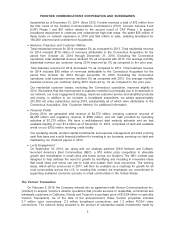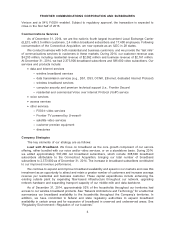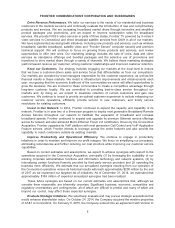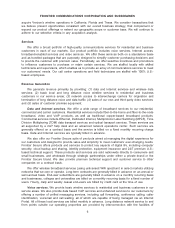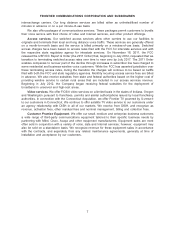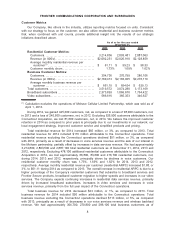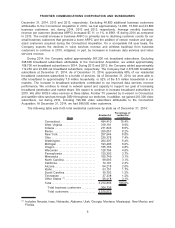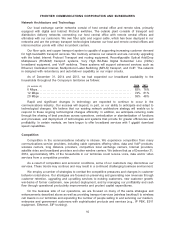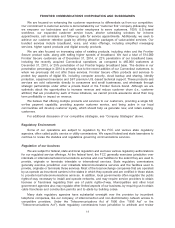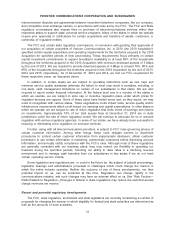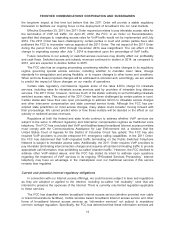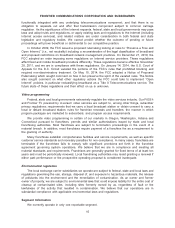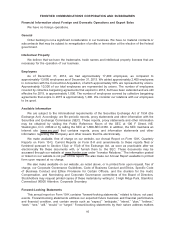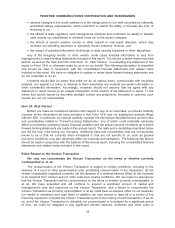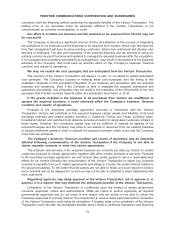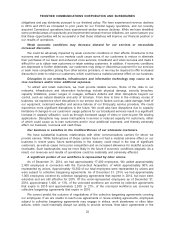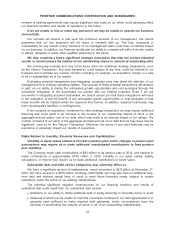Frontier Communications 2014 Annual Report Download - page 14
Download and view the complete annual report
Please find page 14 of the 2014 Frontier Communications annual report below. You can navigate through the pages in the report by either clicking on the pages listed below, or by using the keyword search tool below to find specific information within the annual report.The FCC continues to finalize its Connect America Fund (CAF) Phase II program, which is
intended to provide long-term support for broadband in high-cost areas that were unserved or
underserved by a competitor. The 2011 Order established that price cap carriers, such as Frontier,
would have the right of first refusal to accept support across the high-cost footprint of their state in
exchange for committing to provide broadband and voice services to those areas for a term of years.
On December 18, 2014, the FCC released a Report and Order (the 2014 Order) with final rules for the
right of first refusal for price cap carriers, including increasing the broadband speed obligation to
10 Mbps download, extending the term of funding to six years, and providing flexibility in meeting
deployment obligations. In the 2014 Order, the FCC indicated that it will provide the CAF II offer of
support to the price cap carriers by state in early 2015. At that time, potential CAF II recipients will
have the necessary information—in particular, the offers will include how much support is available to
each provider by state and which locations are eligible to fulfill the broadband deployment obligations—
to decide whether to accept the CAF II funding and associated obligations or decline the CAF II
funding. Also according to the 2014 Order, the FCC will conduct a competitive bidding process to
distribute CAF II funding in areas that were exempt from the CAF II right of first refusal offer. Once
finalized, the Company intends to apply to the FCC for support under the 2014 Order.
On November 18, 2011, the FCC adopted the 2011 Order, which changed how federal subsidies
are calculated and disbursed, with these changes being phased-in beginning in July 2012. These
changes transition the Federal Universal Service High Cost Fund (USF), which supports voice services
in high-cost areas, to the CAF, which supports broadband deployment in high-cost areas. CAF
Phase I, which was implemented in 2012 to provide interim support while the FCC developed CAF
Phase II, provided for ongoing USF support for price cap carriers capped at the 2011 amount. In
addition, in the first round of CAF Phase I, the FCC made available for price cap ILECs an additional
$300 million in incremental high-cost broadband support to be used for broadband deployment to
unserved areas. In 2012 and early 2013, we received $72 million in CAF Phase I funds and initially
recorded such funds as increases to Cash and Other liabilities in the balance sheet. The $72 million in
the first round of CAF Phase I support is expected to enable an incremental 92,877 households for
broadband service and was accounted for as Contribution in Aid of Construction. We are required to
spend the first round of CAF Phase I funds to enable these households no later than July 24, 2015. We
spent $63 million of the first round of CAF Phase I funds on network expansion through December 31,
2014, enabling 83,100 unserved households.
On May 21, 2013, the FCC released a Report and Order authorizing a second round of CAF
Phase I (the 2013 Order). As part of the 2013 Order, the FCC expanded the areas eligible for funding
to include those that lack service of 3 Mbps download and 768 kbps upload. In 2013 and early 2014,
we received $61 million in the second round of CAF Phase I funds. We are required to spend the
second round of CAF Phase I funds to enable 101,714 households no later than March 14, 2017. The
second round of CAF Phase I includes certain accompanying spending requirements from the
Company, and our capital expenditure plans take this into account. We spent $31 million of the second
round of CAF Phase I on network expansion through December 31, 2014, enabling 80,900 unserved
and underserved households.
In the aggregate, we spent $56 million of the CAF Phase I funds received on network expansion
and upgrades during 2014 and $94 million in total through December 31, 2014, enabling and/or
upgrading 164,000 households.
The 2011 Order also reformed Intercarrier Compensation, which is the payment framework that
governs how carriers compensate each other for the exchange of interstate traffic, and it began a
multi-year transition in July 2012, with the second step implemented in July 2013 and the third step in
July 2014. The transition will move terminating traffic to a near zero rate by 2017. Frontier expects to
be able to recover a significant portion of those revenues through end user rates and other
replacement support mechanisms. The 2011 Order has been challenged by certain parties in court and
certain parties have also petitioned the FCC to reconsider various aspects of the 2011 Order. On
May 23, 2014, the U.S. Court of Appeals for the 10th Circuit issued a decision denying all challenges to
the 2011 Order. Certain parties have continued to appeal that decision. Accordingly, we cannot predict
13
FRONTIER COMMUNICATIONS CORPORATION AND SUBSIDIARIES


